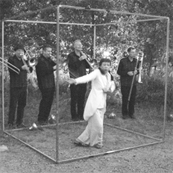“Central to the new-music experience in New York.”
– Time Out NY
“Central to the new-music experience in New York.”
– Time Out NY

The series of works titled stuplimity are early compositional experiments addressing the idiomatic and timbral qualities of the trombone in consort as a medium. Creative concepts for the series were heavily influenced by artist Sol LeWitt's early 70's body of works entitled Variations of Incomplete Open Cubes. The first two pieces were commissioned by choreographer and director Yoshiko Chuma for dance and intermedia performances of her company School of Hard Knocks (SoHK).
Individual compositions in the series include:
stuplimity no. 1 [2005]
for trombone septet
stuplimity no. 1 (trio version) [2005]
for trombone trio
stuplimity no.2 (music for Sundown) [2006]
folio score for 5 or more trombones
stuplimity no.3 [2007]
for solo trombone and live-electronics
I identified the title, a neologism combining stupefy and sublime, while reading an essay on LeWitt's Variations… Sianne Ngai, the literary theorist who coined the term, defines it as such: "...in experiencing the sublime one confronts the infinite and elemental; in stuplimity, one confronts the machine or system, the taxonomy or vast combinatory, of which one is a part." For years Chuma has utilized several 7x7 foot metal-frame cubes in her work, and I was looking to LeWitt for intertextual inspiration. The conceptual thread through my stuplimity pieces is heavily influenced by LeWitt's goals with his multi-format work. To frame it in musical terms, textural and thematic material recurs throughout but in varying degrees of transformation and temporality.
<<<<>>>>>
Below is the complete "stuplimity" discussion, written by Jonathan Flatley, found in an exhibit book for Variations on Incomplete Open Cubes
Art Machine by Jonathan Flatley, pg. 97
While LeWitt's art emphasizes the gap between the perception of the object and the comprehension of the concept that produced it, the viewer can always bridge the gap. In this sense, the LeWittian aesthetic experience echoes the Kantian sublime, where an initial moment of being overwhelmed is followed by a moment of containment and representation of that which was formerly overwhelming because of its sheer size or its unimaginable force. The experience of LeWitt's work - in a work like the cube series or in a wall drawing such as Lines Not Straight Not Touching - is distinguished from the Kantian sublime however by the fact that it is not the infinite and unrepresentable which overwhelms one at first (as in the sublime) but rather a large finite number. Here, we do not have the romantic experience of triumph as the power of our mind defeats the terror of being overwhelmed. Rather, we are momentarily stupefied by a mass of perceptual data that remains in tension with a relatively simple conceptual schema that organizes that data. The experience is more like what Sianne Ngai has called the "stuplime:" "in experiencing the sublime one confronts the infinite and elemental; in stuplimity, one confronts the machine or system, the taxonomy or vast combinatory, of which one is a part." The sublime pretends to be universal and transcendental, the stuplime is more modest, but also more directly relevant to the social experience of modernity and modernization.